This article was published in issue 55 | kislev 5781 | December 2020
 Excavations in Tell Kuyunjiq – site of ancient Nineveh – from Austen Henry Layard’s travelogue, Nineveh and Its Remains, 1849 Early success, tragic end. George Smith, Illustrated London News, April 4, 1875
Excavations in Tell Kuyunjiq – site of ancient Nineveh – from Austen Henry Layard’s travelogue, Nineveh and Its Remains, 1849 Early success, tragic end. George Smith, Illustrated London News, April 4, 1875 George Smith, a low-level assistant in the Western Asiatic Department of London’s British Museum, was beside himself with excitement. As he scanned the cuneiform signs of the Akkadian inscription, Smith shouted, “I’m the first person to read this in over two thousand years of oblivion!” Leaping from his seat, he ran about like a man possessed. Then, to the utter astonishment of all present, he began stripping off his clothes.
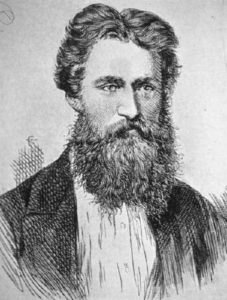 Early success, tragic end. George Smith, Illustrated London News, April 4, 1875
Early success, tragic end. George Smith, Illustrated London News, April 4, 1875 The inscription inspiring this outburst appeared on the eleventh tablet of the Akkadian Epic of Gilgamesh, recounting the Babylonian version of the story of the flood. The tablet, long buried among the ruins of an ancient civilization in Mesopotamia, dates from the seventh century BCE.
In the late 19th century, Sir Henry Rawlinson discovered the key to deciphering Akkadian and the cuneiform characters in which it was written. The breakthrough aroused enormous interest all over the world. In the 1850s, extensive British excavations of the ancient city of Nineveh at Tell Kuyunjiq (near Mosul, in northern Iraq) had unearthed the library of Ashurbanipal, the last great monarch of the Assyrian Empire. Densely inscribed with unintelligible cuneiform text, these thousands of clay tablets were deposited in the British Museum.
George Smith was then only twenty-one, a working-class bank note engraver with no formal education. Intrigued by the tablets whose secrets were gradually being unlocked, he began studying cuneiform to decipher them himself. Rawlinson recommended Smith to the British Museum, where he worked in his spare time for next to nothing. While poring over a cuneiform tablet from Nineveh in 1872, Smith came across a description of a storm, a boat that came to rest atop a mountain, and a bird sent out to find dry land. The biblical parallels were sensational. Unfortunately, the tablet was in poor condition, covered in dust and grime, and Robert Ready, the museum’s restoration expert, was away on business. Smith impatiently awaited Ready’s return and was rewarded in full when, some days later, he read the newly intelligible lines in their entirety.
The young man’s enthusiasm was infectious. He revealed the contents of the tablet in a lecture to the British Biblical Archaeological Society on December 3, 1872, and news of his discovery made headlines in the Daily Telegraph. The inscription of the flood narrative, however, was incomplete. Smith estimated that some fifteen lines were missing where fragments of the tablet had broken off. In exchange for exclusivity, the newspaper agreed to fund a new expedition to Nineveh, headed by Smith, in search of other tablets that might fill in the gaps.
Taking a six-month leave of absence, Smith set out immediately despite the approaching winter. Though hindered by Ottoman bureaucracy and inclement weather, his excavation uncovered tablets that remain part of the museum’s D. T. (Daily Telegraph) Collection. Remarkably fast, he’d identified the missing passage. With their scoop now assured, the paper promptly cut off the Smith’s funding, forcing him to return early. He directed two more expeditions to Mesopotamia but fell ill with dysentery in Aleppo during his third visit, dying at just thirty-six.
Today, almost 150 years after Smith’s discoveries, Assyriologists have a much better grasp of both Akkadian and cuneiform. Enough tablets have been deciphered to reconstruct the entire Akkadian flood myth. Dozens of translations, research papers, and even dramatic renditions are widely available. The first Hebrew translation, by the famous poet Saul Tchernikovsky, was based on a German version. The English translation used below is taken from the first volume of A. R. George’s The Babylonian Gilgamesh Epic (Oxford University Press, 2003).
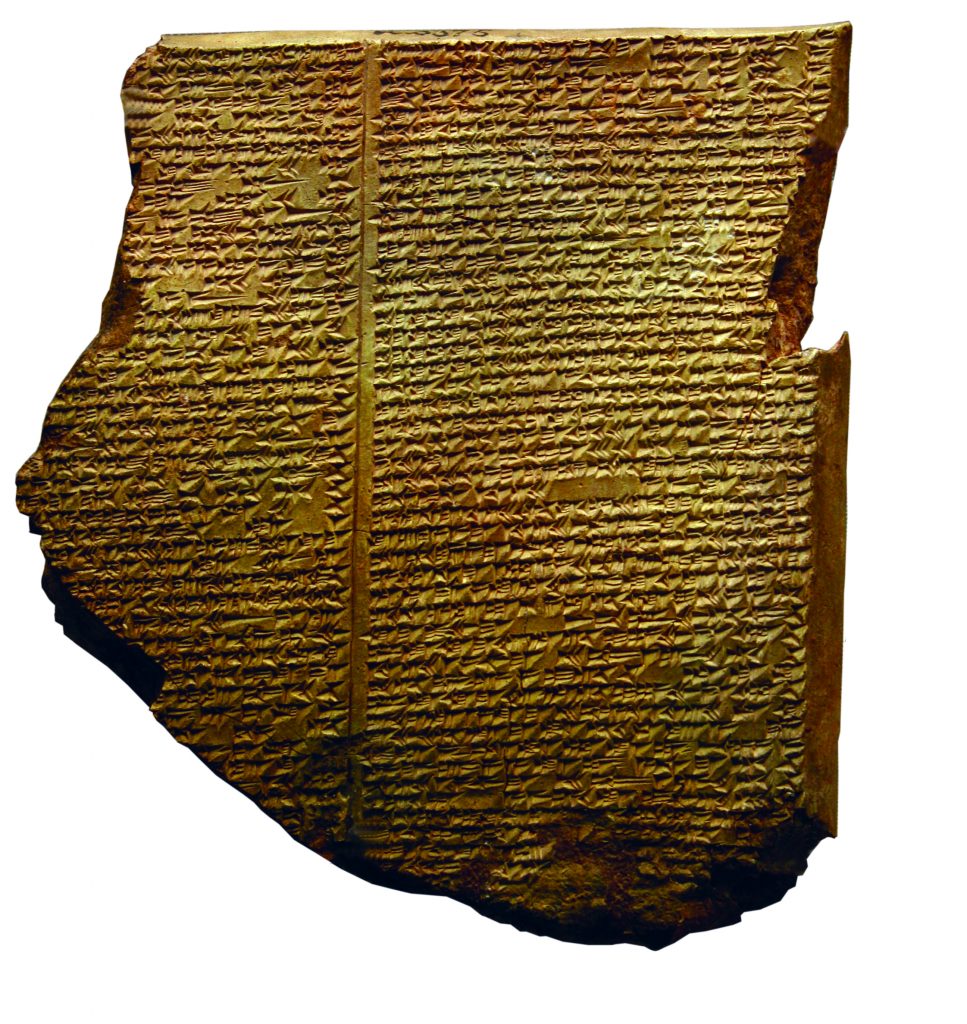 The Akkadian flood story. Tablet XI of the Epic of Gilgamesh, British Museum Collection Photo: Michael Peel
The Akkadian flood story. Tablet XI of the Epic of Gilgamesh, British Museum Collection Photo: Michael PeelHungry Gods
The Akkadian flood story, dating from the end of the first millennium BCE, is a tale within a tale, part of an account of the heroic deeds of Gilgamesh, legendary king of Uruk (biblical Erech). The death of a friend sets Gilgamesh on a quest for immortality, during which he seeks out the man who survived the flood.
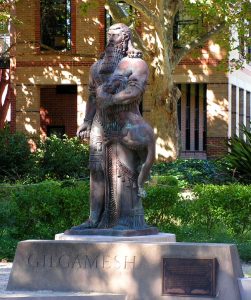 Statue of Gilgamesh, Sydney University, Australia Photo: D. Gordon E. Robertson
Statue of Gilgamesh, Sydney University, Australia Photo: D. Gordon E. RobertsonThe Epic of Gilgamesh wasn’t the only such legend in Mesopotamia. A century of archaeology has unearthed two similar narratives: the myth of Atra-Hasis from the 17th century BCE (almost a thousand years before the Gilgamesh epic), also in Akkadian cuneiform, and an even more ancient Sumerian version.
In each text, the hero’s name reflects his role. In Sumerian, he’s Ziusudra, “(whose) life is until a far-off day”; in Gilgamesh, he’s Uta-napishti, “who found life.” Both appellations relate to the everlasting life bestowed on the protagonist after the flood. Atra-Hasis, in contrast, means “very wise.” The kernel of all the stories seems to be a sage named Ziusudra, son of Ubar-Tutu, who ruled the city of Shuruppak. (One of Mesopotamia’s oldest cities, it’s known today as Tell Fara.) In Gilgamesh, for instance, Uta-napishti is termed a “man of Shuruppak, son of Ubar-Tutu.”
In this epic, the gods decide to destroy mankind, swearing not to reveal their intentions to any of their victims. Yet Ea, god of wisdom and the fresh waters of the abyss, warns Uta-napishti in a dream. Turning to the reed hut in which the sage is resting, Ea advises him to build a boat and save himself and those around him:
Reed fence, reed fence! Brick wall, brick wall!
Listen, O reed fence! Pay heed, O brick wall!
O man of Shuruppak, son of Ubar-Tutu,
Demolish the house, build a boat!
Abandon riches and seek survival!
Spurn property and save life!
Put on board the boat the seed of all living creatures! (George, p. 701)
With his city’s help, Uta-napishti constructs a seven-story boat measuring 120 cubits on each side. He then brings all his family and possessions, animals and craftsmen inside. The next day, a terrible deluge begins:
At the very first light of dawn –
there came up from the horizon a black cloud,
within it Adad [the storm god] did bellow continually.
[The gods] Shullat and Hanish were going at the fore,
‘throne-bearers’ travelling over mountain and land.
Errakal [god of the underworld] was ripping out the mooring-poles;
Ninurta, going (by), made the [dams] overflow.
The Anunnaki [gods] bore torches aloft,
Setting the land aglow with their brilliance.
The [paralyzing terror] of the Storm God passed across the sky,
all that was bright was turned into gloom.
Like an ox [he] trampled the land, he smashed [it like a pot,]
For one day the gale […]
Quickly it blew and the [Deluge …] the east wind,
Like a battle [the cataclysm] swept over the people.
One person could not see another,
nor people recognize each other in the destruction.
Even the gods took fright at the Deluge!
They withdrew, they went up to the heaven of Anu [god of the skies]. (ibid., pp. 709–11)
 “Our Eastern policy.” Caricature of Sir Henry Rawlinson from the satirical magazine Vanity Fair, June 12, 1873
“Our Eastern policy.” Caricature of Sir Henry Rawlinson from the satirical magazine Vanity Fair, June 12, 1873After six days and seven nights, the sea stills and the flood ends. The ship washes up on Mount Nimush, which some identify with Iraq’s Mount Omar-Gudrun. Uta-napishti investigates whether it’s safe to disembark:
I looked at the weather, and there was quiet
But all the people had turned to clay.
The flood plain was level like a roof.
I opened a vent and sunlight fell on the side of my face.
I fell to my knees and sat there weeping,
The tears streaming down the side of my face.
I scanned the shores, the edge of the sea,
In fourteen places emerged a landmass.
On Mount Nimush the boat ran aground,
Mount Nimush held the boat fast and did not let it move.
One day, a second day, Mount Nimush held the boat fast and did not let it move,
A third day, a fourth day, Mount Nimush held the boat fast and did not let it move,
A fifth, a sixth, Mount Nimush held the boat fast and did not let it move.
When the seventh day arrived –
I brought out a dove, setting it free:
Off went the dove …
No perch was available for it and it came back to [me.]
I brought out a swallow, setting it free:
Off went the swallow …
No perch was available for it and it came back to me.
I brought out a raven, setting it free:
Off went the raven and it saw the waters receding.
It was eating, bobbing up and down, it did not come back to me. (ibid., pp. 711–3)
Upon leaving the boat, Uta-napishti offers a sacrifice.
I brought out an offering and sacrificed to the four comers of the earth.
I strewed incense on the peak of the mountain.
Seven flasks and seven I set in position,
Below them I heaped up (sweet) reed, cedar and myrtle.
The gods smelled the savour,
The gods smelled the sweet savour,
The gods gathered like flies around the sacrificer. (ibid., p. 713)
Having partaken of the offering, the mother goddess swears by her necklace of fly-shaped lapis lazuli beads, which symbolize the hungry gods descending on the gift of food but also signify man’s fleeting lifespan. She vows to remember the deluge forever. In the parallel myth of Atra-Hasis, the gods pledge never to repeat the flood, promising mankind will always endure. And in the Gilgamesh epic, the gods reward Uta-napishti and his wife with eternal life: “In the past Uta-napishti was (one of) mankind, but now Uta-napishti and his woman shall be like us gods!” (ibid., p. 717).
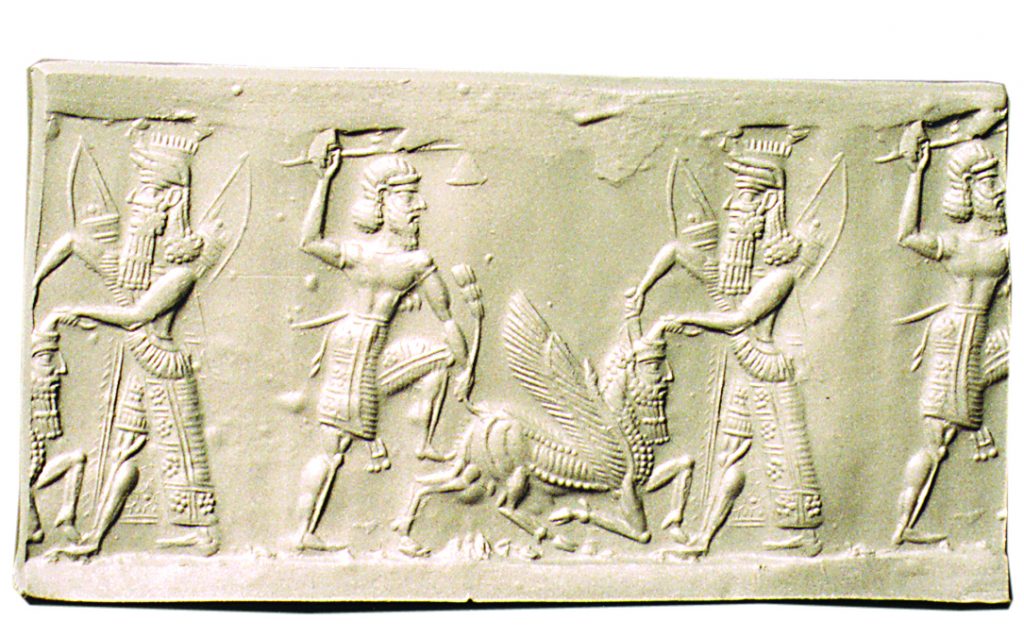 Gilgamesh and comrade Enkidu slaying the bull of heaven. Modern clay imprint from a cylinder seal dating from the seventh century BCE Courtesy of the Schøyen Collection, Oslo and London
Gilgamesh and comrade Enkidu slaying the bull of heaven. Modern clay imprint from a cylinder seal dating from the seventh century BCE Courtesy of the Schøyen Collection, Oslo and LondonUnfathomable Motives
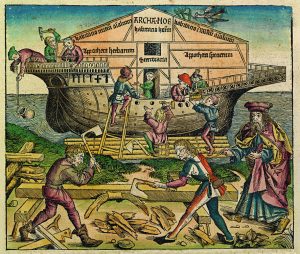 Construction of the ark. Illustration from the Nuremberg Chronicle, 1493
Construction of the ark. Illustration from the Nuremberg Chronicle, 1493The Bible is rife with parallels to the literary works of Sumer and Akkad, but none come close to the number of striking similarities between Noah’s ark and the Akkadian myth of the deluge. In both accounts, one man is chosen to save creation by bringing its various species into an ark, which then comes to rest atop a mountain, after which he offers a sacrifice and the gods (or God) take an oath. Most strikingly, both heroes send out birds to ascertain the viability of life on dry land. There’s clearly a profound cultural connection between the two narratives.
Their differences, however, reflect subtle shifts in perspective between the two cultures. Both accounts depict a relationship between man and the divine, but from different angles. The biblical focus is moral: mankind has sinned – “the earth was filled with violence” (Genesis 6:13) – and the flood is retribution. The Gilgamesh story, by contrast, gives no reason for the gods’ decision to destroy mankind – or for Ea’s wish to save it.
The Atra-Hasis narrative does provide a rationale for the destruction: the growing human population spreading over the earth generates noise, which disturbs the gods.Perhaps the omission of any such explanation in the Gilgamesh epic reflects the conviction that the gods’ motives in inflicting calamity upon man were unfathomable. Their anger could wreak destruction in the blink of an eye for no apparent reason; the deluge was just the most extreme example. Hence man’s constant pacification rituals – daily sacrifices, for example – aiming to keep the gods’ anger in check.
The Babylonian narrative also subtly highlights the gods’ dependence on humanity. Life in the Fertile Crescent requires constant renewal of the network of mud canals channeling water to the rich, alluvial soil where rainfall is sparse. Mesopotamian myths describe how the gods themselves initially labored over these waterworks, then tired and created man to work in their place. Man toils not only to provide for himself, but to feed the gods meal offerings and other sacrifices. During the flood, when humankind was all but wiped out, the gods hungered, and when Uta-napishti emerged from his ark and offered them a sacrifice, they swarmed about it like flies, having eaten nothing for seven days.
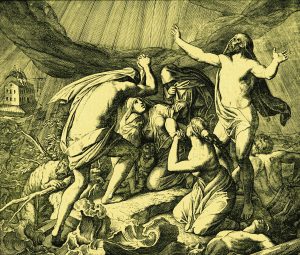
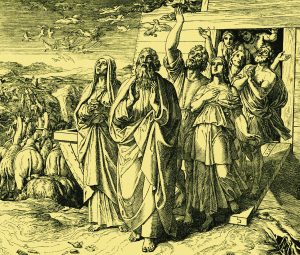
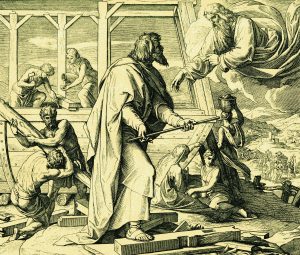 Three scenes from the biblical flood story: God warns Noah, the deluge, and leaving the ark. Illustrations from Julius Schnorr von Carolsfeld’s Bible in Pictures, 1852–60
Three scenes from the biblical flood story: God warns Noah, the deluge, and leaving the ark. Illustrations from Julius Schnorr von Carolsfeld’s Bible in Pictures, 1852–60 Renew Our Days
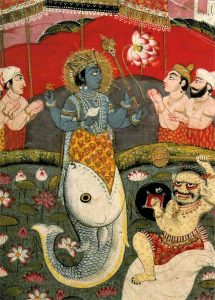 Incarnation of the Hindu god Vishnu as a fish, from a devotional text reproduced in K. E. Sullivan’s Indian Myths and Legends, 1998
Incarnation of the Hindu god Vishnu as a fish, from a devotional text reproduced in K. E. Sullivan’s Indian Myths and Legends, 1998 The Gilgamesh epic is thus deeply rooted in ancient Mesopotamian culture. The flood represents the utter chaos and destruction always lurking just beyond the boundaries of human order.
A whole world of imagery developed around this narrative. For example, a city obliterated by storm or conquest was called Tilli Abubi in Akkadian, meaning “a mound (tell) of the flood,” a heap of ruins left in the wake of the deluge. The parallel phrase in Hebrew is Tel Aviv, which appears in Ezekiel (3:15) as one of the desolate locations in which the Judeans exiled to Babylonia settled. The expression is often used in Babylonian and Assyrian royal inscriptions as a threat. In the concluding sentences of Hammurabi’s Code, for example, the king curses any monarch who breaks his laws: “May Adad [the storm god] make his land into flood-hills.” Sennacherib of Assyria describes his victory over an enemy in similar terms: “I destroyed, devastated, and burned with fire his cities, and made them like flood-hills” (A. K. Grayson and J. Novotny, The Royal Inscriptions of Sennacherib, King of Assyria (704–681 BC), part 2 [Eisenbrauns, 2014], p. 82).
The Babylonian concept of time was also shaped by the flood, which divided the ages into two distinct periods – pre- and post-cataclysm. According to the Sumerian lists of kings, those preceding the deluge ruled for tens of thousands of years, while those postdating it, for mere centuries. Later the reigns are reduced even further, matching a regular human lifespan. A parallel process is described early in the book of Genesis.
Other changes, too, mark the transition between epochs. Before the flood, there is no history, only myth.
In Babylonian tradition, the gods knew all manner of wisdom and craft, every sacred mystery and rite, every floorplan of every temple. Man was privy to this knowledge as well, but with the flood, all was forgotten. Humanity has been seeking this lost wisdom ever since.
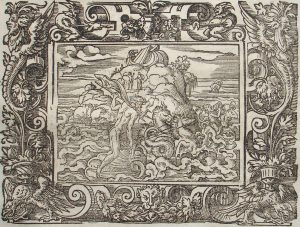 Deucalion and Pyrrha repopulate the earth. Engraving by Virgil Solis for Ovid’s Metamorphoses, Frankfurt, 1581
Deucalion and Pyrrha repopulate the earth. Engraving by Virgil Solis for Ovid’s Metamorphoses, Frankfurt, 1581The flood was a religious watershed (as it were), destroying temples and sweeping their rituals into oblivion. As a result, Gilgamesh’s encounter with Uta-napishti is not just another milestone in the hero’s quest to become the ideal king of Mesopotamia, but a powerful moment in which antediluvian past and postdiluvian present meet. Gilgamesh can now recover the secret rites of old from one who knew them firsthand and ensure they’re performed correctly in the temples. In a crumbling section of the tenth tablet of the epic, Uta-napishti instructs Gilgamesh to rebuild the temples as they were before the flood. The same sentiment is expressed at the beginning of the work:
He who saw the Deep, [the] foundation of the country,
[Who knew secrets,] was wise in everything!
[Gilgamesh, who] saw the Deep, the foundation of the country,
[Who] knew [secrets], was wise in everything! […]
He [learnt] the totality of wisdom about everything.
He saw the secret and uncovered the hidden,
He brought back a message from the antediluvian age. (ibid., p. 539)
Gilgamesh thus reinstated the old rituals. The secret of his success and the vital truth he reclaimed are both briefly summarized in the opening lines of his epic:
[Gilgamesh] who scoured the world-regions ever searching for life,
And reached by his strengths Uta-napishti the Far-Away;
[Gilgamesh] who restored the cult-centres that the Deluge destroyed
And established the proper rites for the human race!
Who is there that can be compared with him in kingly status,
And can say like Gilgamesh, “It is I am the king”? (ibid., p. 541)
Gilgamesh represents the ideal Mesopotamian king, responsible not only for law and order but also for religious life. As such, the story of the flood isn’t just another literary element enhancing the narrative; it establishes Gilgamesh as restorer of the relationship between men and gods in a postdiluvian world. All Mesopotamian monarchs were bidden to follow in his footsteps, providing sacrifices for temple worship, appeasing the gods, and thus maintaining the balance of the world forever.
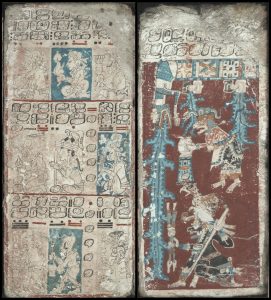 Mesoamerica has its own flood narratives. The Mayan myth of the flood, from the Dresden Codex, the oldest extant Mayan manuscript. Dating from the 11th or 12th century, its narrative was based on a much earlier text and, as it predates the Spanish conquest of South America, is clearly not biblically influenced Courtesy of the Saxon State and University Library, Dresden
Mesoamerica has its own flood narratives. The Mayan myth of the flood, from the Dresden Codex, the oldest extant Mayan manuscript. Dating from the 11th or 12th century, its narrative was based on a much earlier text and, as it predates the Spanish conquest of South America, is clearly not biblically influenced Courtesy of the Saxon State and University Library, DresdenExtensions
Cracking the Akkadian Code
Both Akkadian and Sumerian were written in cuneiform, which served in both official and everyday capacities for millennia. Deciphering this script took archaeologists decades
A number of cultures in the ancient Near East recorded their languages – most famously Sumerian and Akkadian – in cuneiform. This script’s hundreds of signs contain multiple meanings, with each character representing various syllables and words.
The key to deciphering cuneiform was the enormous Behistun Inscription, incised on a rock face in Behistun, Iran. Darius I (522–486 BCE) had the text inscribed in three languages serving his far-flung empire: ancient Persian, Elamite, and Akkadian, all written in cuneiform. Archaeologists eventually realized that, as the bequest of a famous Persian king, the main inscription was probably in Persian. Aided by context, logic, and other cuneiform Persian inscriptions, German scholar Georg Grotefeld deciphered several characters in 1802, including those meaning “king” and the names of Persian monarchs such as Xerxes and Darius. Other researchers followed in Grotefeld‘s wake, filling in more pieces of the puzzle.
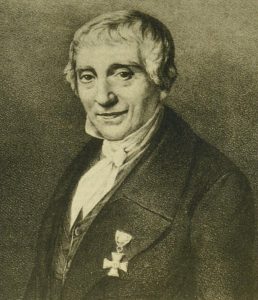 Georg Grotefeld, the first to decipher cuneiform characters from Behistun
Georg Grotefeld, the first to decipher cuneiform characters from BehistunThe entire Behistun Inscription was deciphered largely by Sir Henry Rawlinson, a British army officer. Building on the signs already identified, he completed the decoding of the Persian section, then compared the parallel inscriptions to decipher the Akkadian – a real breakthrough. Although he labored from 1835 to 1853, his success is officially dated to 1857, when the British Royal Asiatic Society invited Rawlinson and three other scholars to work separately on deciphering another Akkadian cuneiform inscription. The four translations, each submitted to the society in a sealed envelope, were almost identical, showing that both Akkadian and cuneiform could now be read.
Akkadian has two main dialects: Babylonian, spoken in the south, and Assyrian, in the north (unrelated to today’s Assyrian or Syriac, an Aramaic dialect). Though Akkadian stopped being spoken in the final centuries before the Common Era, scholars can understand it by drawing on other Semitic languages, such as Hebrew, Arabic, Aramaic, and the Ethiopian Ge’ez. Preserved in hundreds of thousands of cuneiform-inscribed clay tablets, Akkadian is fairly comprehensible today.
Cuneiform was invented by the Sumerians. Soon after mastering the art of reading it, researchers noticed many tablets written in two columns – apparently dictionaries comparing Akkadian with some non-Semitic language. In 1869, a French-German Jew named Julius Oppert identified it as “Sumerian,”an adjective he took from Akkadian inscriptions.
Sumerian doesn’t belong to any language group known today. It began to be written down with the invention of cuneiform at the end of the fourth millennium BCE and was still spoken toward the end of the third. It then became a language used by priests and scholars for sacred purposes, until cuneiform fell out of use in the first century CE. Though still not as intelligible to scholars as Akkadian, Sumerian texts are now basically accessible.
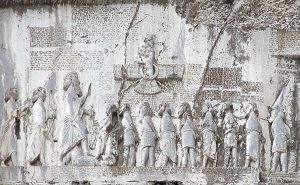 What the Rosetta Stone did for hieroglyphics, the Behistun Inscription did for cuneiform – except that none of the three languages inscribed in parallel on the rock face (ancient Persian, Elamite, and Akkadian) were understood when it was discovered. The inscription and a bas-relief showing Darius and the enemies he defeated to secure his empire
What the Rosetta Stone did for hieroglyphics, the Behistun Inscription did for cuneiform – except that none of the three languages inscribed in parallel on the rock face (ancient Persian, Elamite, and Akkadian) were understood when it was discovered. The inscription and a bas-relief showing Darius and the enemies he defeated to secure his empireWater, Water, Everywhere
Ancient Flood Legends: A Selection \\ Sara Jo Ben Zvi
Saved by a Fish God | Hindu
 Fish incarnation of Vishnu, Uttar Pradesh, India, circa 1870 Victoria and Albert Museum, London
Fish incarnation of Vishnu, Uttar Pradesh, India, circa 1870 Victoria and Albert Museum, London Vishnu, one of the three greatest Hindu deities, took the form of a fish to warn the first man, Manu, that a flood was imminent. This fish towed Manu’s ship (with seven sages aboard) to safety on a mountaintop high above the waters.
Some Hindu sources refer to a flood that destroys the world every few thousand years, washing corrupt mankind clean.
Take Three | Mayan
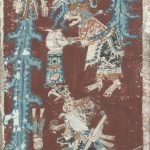 Courtesy of the Saxon State and University Library, Dresden
Courtesy of the Saxon State and University Library, DresdenMan was created after animals failed to praise the gods. Made of mud, these “humans” dissolved in water. Next the gods carved men out of wood, but they too ignored their makers and were wiped out by predators, rain, and floods. Finally, men made from corn established the earth.
Frozen Flood | Zoroastrian
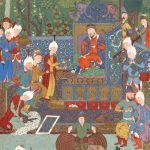 Illumination of the court of Jamsheed, from a manuscript of the Shahnameh epic poem Courtesy of Princeton University Library
Illumination of the court of Jamsheed, from a manuscript of the Shahnameh epic poem Courtesy of Princeton University LibraryThe gods sent a severe winter to destroy the world, but not before Ahura Mazda, lord of wisdom, warned King Yima (or Jamshid) to build a bunker large enough to hold two of every animal, a sample of every plant, and a select group of men. After the frost thawed, the survivors rebuilt both creation and humanity.
Stone Age | Greco-Roman

Zeus and his fellow deities decided to wash away mankind in a flood for having sunken into depravity and offering human sacrifice. The Titan Prometheus revealed the scheme to his human son, Deucalion, and told him to build a chest in which to hide. Deucalion and his wife Pyrrha survived, floating for nine days until their chest struck ground on Parnassus, mountain of the gods. After the waters receded, Deucalion sacrificed a thanksgiving offering to Zeus, who ordered him and his wife to repopulate the earth by throwing stones over their shoulders. Pyrrha’s stones became women, and Deucalion’s, men.
Flood of Blood | Norse
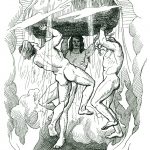 Odin and his brothers create the world from the body of Ymir, by Lorenz Frølich, 1800s
Odin and his brothers create the world from the body of Ymir, by Lorenz Frølich, 1800sYmir, the primeval being, sprang from a combination of heat and cold. Frost ogres emerged from his bodily fluids, and the first man, Bor, appeared out of ice. Bor’s son Odin and his two brothers killed Ymir, whose blood flooded the earth, drowning all the ogres except the giant Bergelmir, who escaped with his wife in a hollowed-out tree trunk. From Ymir’s body, Odin created the world.
Further reading:
Andrew R. George, The Babylonian Gilgamesh Epic: Introduction, Critical Edition and Cuneiform Texts (Oxford University Press, 2003); David Damrosch, The Buried Book: The Loss and Rediscovery of the Great Epic of Gilgamesh (Henry Holt and Co., 2007).
